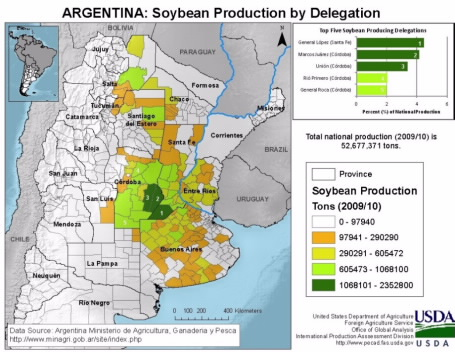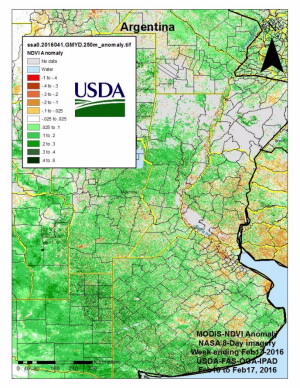Argentina Soybeans: Potential Bumper Harvest Could Necessitate Temporary Storage
Argentina’s 2015/16 soybean crop has benefited from abundant rain during the growing season in the main production region, but the crop now needs a period of favorably dry fall weather during maturation to ensure proper dry-down of the beans prior to harvest and storage. Production is forecast at 58.5 million tons, second only to last year’s harvest of 61.4 million tons. Area is estimated at a record 20.0 million hectares and yield is forecast at 2.92 tons per hectare, down 7.9 percent from last year’s record. Early-sown soybeans in northern and central Argentina are initiating pod differentiation prior to seed-fill, and harvest will begin in March.
If 2015/16 output reaches the forecast level, Argentine farmers will likely have to increase temporary on-farm storage capacity prior to the delivery of the crop to processing or export facilities. One way to achieve this is through the use of the silo bolsa, a type of grain-storage bag. Silo bolsas are a popular method of storing grain in Argentina. They are made of thick, triple-layer polyethylene with UV filter. The grain-storage capacity is typically about 200 metric tons per bag. The use of silo bolsas would require farmers to ensure that the beans are harvested at the proper moisture level in order to prevent temperature fluctuation and spoilage in the bags. If the moisture in the beans is too high, moisture can migrate to the surface and condense on the grain that is in contact with the inner liner of the silo bolsa and spoilage can occur. High moisture can also result in localized heating within the bags. The key for proper storage is to harvest the soybeans at a suitable moisture level, and an extended period of dry weather during crop maturation would facilitate proper dry-down of the crop prior to storage. Soybeans can be stored in silo bolsa bags for up to four months without a significant deterioration in quality.



Most of the main Argentina soy region received heavy rains fell during the third week of February 2016. |
MODIS NDVI indicate above-average crop conditions in most the main soybean region of Argentina. |
Current USDA area and production estimates for grains and other agricultural commodities are available on IPAD's Agricultural Production page or at PSD Online.
Visit Crop Explorer http://www.pecad.fas.usda.gov/cropexplorer/
|

